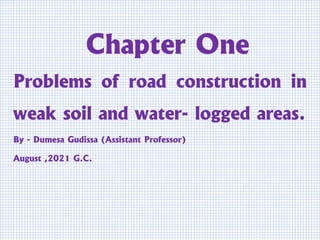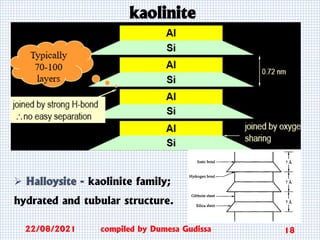Ceng chapter 1
- 1. Chapter One Problems of road construction in weak soil and water- logged areas. By - Dumesa Gudissa (Assistant Professor) August ,2021 G.C.
- 2. ‚ùñ take a minute to think about the question 1. What is the importance of quantifying the damage of pavement layers due to problematic soils? 2. Which soils are categorized as a problematic soils and remedial measurers should be take to use as subgrade material? 3. Why do expansive soils expand? Which minerals are responsible for expansiveness? 4. Is it possible to construct roads in water logging areas? 5. What are the remedial measures to should be taken for roads in waterlogged areas ? 22/08/2021 compiled by Dumesa Gudissa 2
- 3. Introduction 22/08/2021 compiled by Dumesa Gudissa 3 expansive soil with crack
- 4. Introduction 22/08/2021 compiled by Dumesa Gudissa 4 Damage due to problematic subgrade condition
- 5. Introduction ‚ùëThe performance of any types of completed roads are depend on the pavement structural design and subgrade soil conditions. ‚ùë Subgrade soil that changes their volumetric and stiffness properties leads to deformation and cracking of road surface, frequently leading to premature failure. ‚ùë The most problematic subgrade soils including expansive/swelling soil, highly compressible soft soils and saturated soils. compiled by Dumesa Gudissa 5 22/08/2021
- 6. Cont. . . . ‚ùëIn water stagnated areas where the water table is fluctuating and vegetational growth possible swamp and marsh deposits develop. ‚ùë soil formed under this environment is soft, high in organic content. ‚ùëAccumulation of partially or fully decomposed aquatic plants in swamps or marsh is termed Muck or Peat. ‚ùëMuck is spongy, light in weight, highly compressible, and not suitable at all for construction purposes of any kind. 22/08/2021 compiled by Dumesa Gudissa 6
- 7. Cont. . . ‚ùëwhy expansive soil and collapsible soil are labelled as a problematic soils? ‚ùñ expansive or collapsible soil may cause high differential movements in structures through excessive heave or settlement. ‚ùë problematic soils(soft and unstable subgrade conditions) may not identified during subsurface investigation and can be detected during the construction phase, this may led to claims and construction cost overruns. 22/08/2021 compiled by Dumesa Gudissa 7
- 8. Cont. . . ‚ùëExpansive soil is generally defined as any soil or rock material that has a potential to increase in volume under increasing water content. ‚ùëCollapsible soil, which are sometimes referred to as metastable soil, are unsaturated soil that undergo a large change in volume upon saturation. ‚ùëSwelling and shrinkage of sub-grade soils are critical factors contributing to increases in roughness and degradation of serviceability of highway pavements. compiled by Dumesa Gudissa 8 22/08/2021
- 9. Distribution of Expansive Soils ‚ùë The problems with expansive soils is widespread throughout world except acratic. ‚ùëThe countries that are facing problems with expansive soils are Australia, the US, Canada, China, Israel , India , and everywhere. ‚ùë It was projected that by the year 2000, losses due to expansive soil would exceed 4.5 billion dollars annually(Chen,1988) 22/08/2021 compiled by Dumesa Gudissa 9
- 10. Expansive soil distribution in Ethiopia 22/08/2021 compiled by Dumesa Gudissa 10
- 11. Description of Expansive/swelling soil ‚ùëExpansive or swelling soils are generally clayey soil types that are susceptible to volume change due to seasonal fluctuations in moisture content. ‚ùë A decrease in moisture will cause these soils to shrink, while an increase in moisture will cause expansion or swelling. ‚ùë The clay mineral that is responsible for expansiveness belongs to the montmorillonite group. 22/08/2021 compiled by Dumesa Gudissa 11
- 12. Cont. . . ‚ùëExpansive soils are residual soils which are the result of weathering of the parent rock. ‚ùëThe swell - shrink potential of expansive soils is determined by its initial water content; void ratio; internal structure and vertical stresses, as well as the type and amount of clay minerals in the soil. ‚ùëSwelling pressures can cause heaving, or lifting of structures whilst shrinkage can cause differential settlement. Failure results when the volume changes are unevenly distributed beneath the structures 22/08/2021 compiled by Dumesa Gudissa 12
- 13. Cont. . . ‚ùëSwelling and shrinkage are not fully reversible processes. ‚ùëThe process of shrinkage causes cracks, which on re-wetting, do not close-up perfectly and hence cause the soil to bulk-out slightly, and also allow enhanced access to water for the swelling process. ‚ùëIf these soils were left untreated, longitudinal cracks and significant surface roughness issues can be expected on the finished pavement surface. 22/08/2021 compiled by Dumesa Gudissa 13
- 14. Characteristics of Expansive Soil ‚ùë Increases in volume with the addition of water. ‚ùë They shrink greatly on drying and develop cracks on the surface. ‚ùë These soil possess a high plasticity index. ‚ùë their colour varies from dark grey to black. 22/08/2021 compiled by Dumesa Gudissa 14 . Shrinkage cracks are visible on the ground during dry seasons.
- 15. Clay minerals • All clay minerals are made of two distinct building blocks: tetrahedrons and octahedrons. • The tetrahedron has oxygen atoms at the corners, and there is a silicon in the center. • Octahedron has six oxygen or hydroxyl atoms in the corners, and an aluminum or magnesium ion at the center. 22/08/2021 compiled by Dumesa Gudissa 15
- 16. Cont. . . ‚ùëSeveral tetrahedrons joined together form a tetrahedral sheet. ‚ùëDifferent combinations of tetrahedral and octahedral sheets form different clay minerals: ‚û¢1:1 Clay Mineral (e.g., kaolinite, halloysite): 22/08/2021 compiled by Dumesa Gudissa 16 hexagonal hole
- 17. Cont. . . ‚û¢2:1 Clay Mineral (e.g., montmorillonite, illite) 22/08/2021 compiled by Dumesa Gudissa 17
- 18. kaolinite 22/08/2021 compiled by Dumesa Gudissa 18 ‚û¢ Halloysite - kaolinite family; hydrated and tubular structure.
- 19. Cont. . . ‚ùëMontmorillonite- also called smectite; expands on contact with water. 22/08/2021 compiled by Dumesa Gudissa 19 ‚û¢Highly reactive (expansive ) clay. ‚û¢ Bentonite - montmorillonite family
- 20. Cont. . . 22/08/2021 compiled by Dumesa Gudissa 20 Illite
- 21. Identification clay minerals ‚ùë Scanning Electron Microscope ‚ùë X-ray diffraction (XRD)- to identify the molecular structure and minerals present. ‚ùë Differential Thermal Analysis (DTA) - to identify the minerals present 22/08/2021 compiled by Dumesa Gudissa 21 plate-like structure
- 22. Cont. . . ❑Casagrande’s Plasticity Chart 22/08/2021 compiled by Dumesa Gudissa 22
- 23. Damage to Structures from Expansive Soil ‚ùëAll pavement structures experience various levels of damages during their lifetime. For structures to be economical especially those made of concrete, a certain degree of cracking is inevitable. ‚ùëSwelling pressures can cause heaving, or lifting of structures whilst shrinkage can cause differential settlement. Failure results when the volume changes are unevenly distributed beneath the pavement foundation. 22/08/2021 compiled by Dumesa Gudissa 23
- 24. Cont. . . ‚ùëOften, damage from expansive soils can be seen within the first few months or years after a pavement is constructed. ‚ùë As water from irrigation or rainfall migrates underneath the pavement foundation, the soil around the edge of the pavement foundation expands, pushing up on the edges of the pavement. ‚ùë This condition, called edge-lift, can cause cracking of surface course of pavement. 22/08/2021 compiled by Dumesa Gudissa 24
- 25. Cont. . . ‚ùëOver a period of years, as the moisture further migrates underneath the center of the pavement , center-lift can occur, causing additional damage to the pavement. 22/08/2021 compiled by Dumesa Gudissa 25
- 26. Road construction in water logged areas ‚ùëWhen water from any source find no path to escape or drain out and create a hazardous situation is known as water logging. ‚ùëAs a result of migration of water by capillary action from the high-water table/high flood level, the subgrade soil gets further saturated and this leads to a gradual loss in its bearing capacity. ‚ùëIt is important to ensure the drainage of storm water and lowering of subsoil water so that subgrade remains dry. 22/08/2021 compiled by Dumesa Gudissa 26
- 27. Cont. . . ‚ùëAbsence drainage system, improper maintenance of drainage facilities may cause waterlogging during rain season. ‚ùë Many roads in Ethiopia have deteriorated in areas with high water tables. 22/08/2021 compiled by Dumesa Gudissa 27
- 28. Cont. . . ‚ùëThe rise in water table causes a capillary rise of water into the sub-grade. ‚ùëWith this upward flow of water, the injurious salt such as sulphates, chlorides and carbonates of sodium, calcium and magnesium which are present in the water also rises towards the surface. ‚ùëThese salts increase in volume when they crystallize under a suitable condition. ‚ùëThe repeated volume changes of salts due to alternate hydration and dehydration leads to breaking of pavement. 22/08/2021 compiled by Dumesa Gudissa 28
- 29. Solution of Road Construction in Water Logged Area ‚ùëThis problem can be resolved by taking variously measured. ‚ùë One of the most effective measures is to depress the water table (lowering water table) ‚ùëThis can be achieved by a system of a sub-surface drain. ‚ùëThe other alternative is to keep the road embankment sufficiently high. ‚ùëThe bottom of the pavement should be kept at least 1.5 m above the highest water table. 22/08/2021 compiled by Dumesa Gudissa 29
- 30. Cont. . . ‚ùë Provision of capillary cut-off placed 0.15 m above the ground level can effectively arrest the rise of water. ‚ùë Capillary cut-off may be provided in the form of a sand blanket, bituminous stabilized soil. ‚ùëProvision of suitable type and grade of Geotextile over the sub-grade also effectively serves as a cut-off for the capillary rise of water and salt migration. ‚ùëThe pavement should also be designed adequately for adverse conditions. 22/08/2021 compiled by Dumesa Gudissa 30
- 31. Cont. . . ‚úìLowering water table to protected damage of pavement layers. 22/08/2021 compiled by Dumesa Gudissa 31
- 32. Cont. . . 22/08/2021 compiled by Dumesa Gudissa 32 Seepage control
- 33. Cont. . 22/08/2021 compiled by Dumesa Gudissa 33 Capillary cut-off : (1) with Granular capillary cut-off (2) Impermeable capillary cut-off
- 34. Cont. . . ‚ùë Provision of capillary cut-off placed 0.15 m above the ground level can effectively arrest the rise of water. ‚ùë Capillary cut-off may be provided in the form of a sand blanket, bituminous stabilized soil. ‚ùëProvision of suitable type and grade of Geotextile over the sub-grade also effectively serves as a cut-off for the capillary rise of water and salt migration. ‚ùëThe pavement should also be designed adequately for adverse conditions. 22/08/2021 compiled by Dumesa Gudissa 34
- 35. Next . . . Chapter 2 Methods of strengthening weak pavement subgrade soil 22/08/2021 compiled by Dumesa Gudissa 35


































